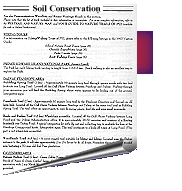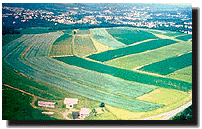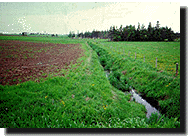

As more and more Island fields
are turned over to potato production, the need for soil
conservation measures becomes increasingly necessary.
Fields at low, medium, or high risk of erosion will
require different combinations of measures to reduce soil
loss. Fields at low risk for erosion can be protected
using annual crop rotation, a long-term strategy
involving the planting of cereals and forage crops in
sequence with potatoes. Crop rotation improves soil
organic matter levels, increases rooting depth, reduces
soil compaction, and improves soil fertility and weed
control. Together, these improvements result in better
crop quality and higher yields.
In combination with crop rotation, fields at moderate
risk for erosion require conservation tillage, winter
cover, strip cropping, and cross slope farming.
Conservation tilling (or residue management) protects the
soil from the impact of rain by creating the effect of
small dams and windbreaks. This technique involves
leaving plant remnants from the previous season’s
crop on the field when planting for the current season.
The planting of winter cover crops, such as fall rye and
winter wheat, is the most cost-effective approach to soil
conservation. Fields planted with early-maturing potato
varieties are best suited to winter cover, giving the
cover crop sufficient time to establish itself before the
onset of winter. In addition to reducing erosion, cover
crops add organic matter, improve soil structure,
suppress weed growth and, in the case of legumes, provide
valuable nitrogen for the next potato crop. Where later
potato varieties are grown, straw or hay mulches can
provide a good alternative winter field cover.
Cross-slope farming reduces the erosive effects of the
channels normally created during ploughing and
cultivation. Tilling and planting across the
slope creates a series of dams that slow runoff and
redirect it, allowing it to soak into the ground or to
float between the rows of potatoes until it reaches
grassed headlands or waterways. On longer slopes,
cross-slope farming is best combined with strip cropping
and/or terraces. In addition to reducing  the
risk of erosion, cross-slope farming increases the
availability of moisture during the growing season.
Moreover, cross-slope farming entails no additional
expense to farmers.
the
risk of erosion, cross-slope farming increases the
availability of moisture during the growing season.
Moreover, cross-slope farming entails no additional
expense to farmers.
Strip cropping combines the soil and moisture
conservation of cross-slope farming with the
soil-building advantages of crop rotation. This measure
sees farmers alternating strips of grain and/or forage
crops across a slope. Grass headlands further protect
against erosion and provide access lanes to each strip.
Three-year strip rotations of potatoes, grain, and hay
reduce erosion by 75 percent compared to farming one crop
planted in rows up and down the slope.
Areas at high risk for erosion should combine the
foregoing elements with erosion control structures such
as terraces, surface inlets, grassed waterways (all of
which slow or redirect water flow) and hedgerows
(designed to protect against wind erosion). The planning,
design, and construction of such structures are best
handled by qualified professionals. Terraces break up
long slopes into a series of shorter slopes, with each
successive terrace catching surface water from the one
above it. Surface inlets or grassed waterways carry the
intercepted water to prevent it from  travelling
the length of the slope. These broad, shallow
grass-covered channels control gully erosion (where water
collects and flows through natural depressions).
Unfortunately, waterways permanently remove land from
cereal and row crop production. Surface inlets and
underground piping systems avoid this drawback by
intercepting runoff, piping it, and discharging the water
in a safe and convenient location.
travelling
the length of the slope. These broad, shallow
grass-covered channels control gully erosion (where water
collects and flows through natural depressions).
Unfortunately, waterways permanently remove land from
cereal and row crop production. Surface inlets and
underground piping systems avoid this drawback by
intercepting runoff, piping it, and discharging the water
in a safe and convenient location.
Hedgerows are treed windbreaks that provide many benefits
to potato production. Erosion control is effected by
reducing wind speed at ground level and by trapping snow
on the field, thus keeping it covered during the winter
months. Well-established hedgerows, planted at right
angles to the prevailing winter winds, can control snow
drifting for a distance equal to ten times the height of
the break. Wind speeds over down wind areas can be
reduced for twice this distance.
Erosion | Ground Water Quality | Surface Water Quality |
Forestry Practices | Natural Disasters | Irving Whale